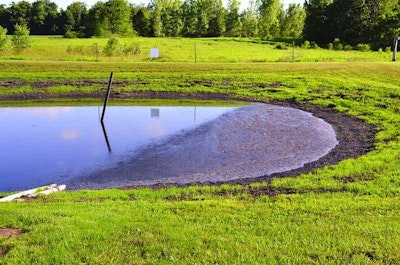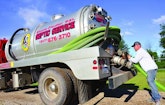
Interested in Onsite Systems?
Get Onsite Systems articles, news and videos right in your inbox! Sign up now.
Onsite Systems + Get AlertsWhen Terry and Nancy Fiedler, of Mason, Michigan, bought their first septic company in 1990, they figured it would blend well with their existing landscaping business and provide stable income through difficult economic times. Shunk/Fiedler, and later addition R & L Septic Service, has provided the stability they expected — albeit with a few challenges along the way, including adapting to changes in Michigan’s septage disposal rules.
“I wanted a companion business, something I could do in the winter,” Terry says. He hit on the idea of being a pumper when his own septic system failed, and he called Jerry Shunk. The two talked about the business and Shunk’s plan to retire. By 1990 Shunk was ready, and the Fiedlers purchased his business, which included a 1970 GMC truck with a 1,500-gallon steel vacuum tank.
At the time, septage could be applied year-round, and the Fiedlers rented the same land Shunk had used for application. As planned, Terry had one of his trusted employees take care of pumping during the summer and Terry pumped in the winter.
Then, state regulations tightened.
“They shut us down from Dec. 15 to March 15 for applying on the field. So we have to store everything in the lagoon and wait until springtime and then get it in,” Nancy explains, noting that now it’s a “frozen ground” rule, which still means about three months of shutdown.
So landscaping and pumping occur at the same time. But the Fiedlers have made it work. Terry works with and coordinates the schedule for the landscaping crew, and employee Jason Miller takes care of the pumping. Nancy coordinates the pumping schedule and handles bookwork for both businesses.
“There is a good, complete division of labor,” Terry says, and the businesses are run separately.
LAGOON LOGISTICS
The ability to land-apply has always been the economic dealmaker for the pumping business. When the Fielders bought a second company, R & L Septic, in 1995, they had five 20,000-gallon tanks to store septage before it was field-applied.
Instead of buying more Slurrystore tanks (CST Industries) for additional storage, the Fiedlers decided it was more economical to spend $80,000 for a 200,000-gallon lagoon, including a $10,000 liner. While it took several years to get a return on their investment, the lagoon eliminates wastewater treatment plant fees, hauling (30 miles one way) and waiting time, and helps the Fiedlers keep costs down.
“The lagoon is in the middle of a (640-acre) section. That’s good because it isolates us a little bit,” Terry says. “I have 10 acres and 6 acres that I flip every year that are certified for land application. Soil testing is required once a year to get a license.” The Fiedlers are also required to send notices to neighbors every five years for license renewal.
Jason unloads septage into a concrete trash tank, where a steel bar screen with 3/8-inch gaps captures the “flushable wipes” and other large debris. The septage then flows into the lagoon. When timing and field conditions are right, the septage is pumped back in the truck and spread on the field using a reverse funnel. Terry follows up within six hours with the tractor and disc.
“We apply 20,000 to 30,000 gallons on the field about every week,” Terry says. “It depends on the weather.” Live bacteria, bioForce, from Chempace, is used in the lagoon to break down the septage.
EQUIPMENT INVESTMENTS
With two companies, the Fiedlers inherited a good client base and incorporated both business names for continuity with customers. The trucks from both businesses, however, were old.
While they ran two trucks for a time, they typically have only had one.
“It’s very important with one truck that the truck keeps running,” Terry says, noting he was reminded of that last summer when the transmission went out. He lost two days of work — and possibly customers he’ll never get back.
His strategy has been to upgrade regularly and sell trucks through Pumper magazine classifieds. His current 2010 Freightliner built by Tank Truck Service & Sales Inc. with a 2,500-gallon aluminum tank and Challenger pump will soon be replaced with a newer model. Important features include automatic hydraulic valves and heated collars, which are necessary for Michigan winters. It also has a large-screen Garmin GPS unit to help Jason efficiently plan routes.
Another factor when purchasing a truck is size. Terry sticks to trucks with 2,500-gallon tanks.
“I like that size, because the next size adds an extra axle, and everything is more expensive from the truck to the license,” Terry says. The biggest issue with the tank size is that most new onsite systems he encounters have 1,500-gallon tanks, so only one tank can be pumped instead of two of the older 1,000-gallon tanks common in the area.
“All new systems are engineered in Ingham County,” Terry says. The benefit of that is that they have risers, which makes access easier. About 90 percent of the pumping is residential, and more than half are older systems without risers.
Online maps are available but not very user-friendly, so the customer is sometimes asked to be around when Jason arrives. “We have to know where it (septic line) leaves the house, and he probes,” Nancy says. “About half need to be found. It’s amazing the number of people that have put decks or put cement driveways over them.”
The shovel is a well-used tool in the truck. If deeper digging is required, clients are referred to local excavators.
Jason and Terry also complete septic tank maintenance reports for the county, which are required for home sales. One form for each tank is required.
To help customers schedule pumping, Nancy provides a maintenance log. It reminds them that systems should be inspected and serviced every three to five years, things to avoid putting in the system and room to make notes such as tank location. Her hope is that it educates customers and makes finding tanks easier in the future.
CREDIT CARD EDGE
Another thing that makes it easier for customers is that the Fiedlers offer a credit card option, online and on the phone. “We started doing credit cards about four years ago. We had a lot of requests,” Nancy says. “It’s been a huge boon to us. It’s made a tremendous difference in collections. We don’t have to go back and bug them or track down insufficient checks.”
It’s well worth the $100 per month for credit card services, she says. Jason uses a phone app when customers pay him on location.
The Fiedlers credit their technology-savvy son, Casey, 25, for setting them up with a website and using the right words to get a high number of views, a process called SEO or search engine optimization. He set up Nancy’s computer when she moved her office from the shop to her home in 2008.
“I use Software Control, a basic accounting program for billing and payroll, and if you do inventory, you can take care of that. We started out with that for landscaping, then we took this (pumping) on and use it for that.”
Because of their strong internet presence through Google (at a cost of $300 to $400 per month), the Fiedlers only take out small phone book ads.
LOOKING TO THE FUTURE
At 60, Terry realizes he needs to plan for retirement. The Fiedlers’ children, son Casey and daughter Sam, put in their share of time with the businesses, but have gone on to other careers.
Though he has the most experience with landscaping, he says it’s the business he will let go in a couple of years, because it is more physically demanding.
“We are going to keep the septic business because it pretty much runs itself,” Terry says. One thing the economic downturn illustrated was that people can live without landscaping, Nancy says. Terry’s three crews were reduced to two men, to mostly maintenance and mowing. But people have to have septic tanks pumped, especially when there are problems, she says.
Keeping the pumping business going ensures work for Jason. “Most of my guys have worked for me for 15 years,” Terry says. “We try to treat them right with good compensation.”
With good help and an efficient system in place, the Fiedlers plan to operate their pumping business as long as they can.
“We are seeing the light at the end of the tunnel and will keep doing this as long as it’s a good retirement income,” Terry says. “We don’t need to grow. We are a small ‘mom and pop’ business, and Nancy and Jason have a good rapport with customers. With just one truck, it’s easy to keep a handle on the business and maintain a good reputation.”
Managing a lagoon
Land application of septage saves on disposal fees and time waiting in line at a busy treatment plant. But it also takes planning, preparation and flexibility, says Terry Fiedler, owner of Shunk/Fielder and R & L Septic Service.
He uses two approved fields, 6 and 10 acres, alternating between them every other year. The land is in the middle of 110 acres he owns, which is important to meet regulations for setbacks for wells, property lines and wetlands. A farmer rents all the acres to plant crops for animal feed, except for the land Fiedler uses for applying septage that year. The soil is tested annually. Finding someone to rent his land is easier than finding land to rent, Fiedler says.
Just as in farming, he needs to prep the field. While he had a small tractor for his landscaping business, it was not large enough, and he purchased separate equipment for the pumping business — a John Deere 5000 Series 4WD tractor and a 9-foot disc. If there is time in the fall, he likes to work the field after his renter has harvested the soybean or corn crop. If not, Fiedler works the ground as early as he can in the spring, and he discs often throughout the season.
“I disc in between land applications to keep it in good condition all the time,” Fiedler says. “I don’t want any foliage in the field.”
It’s also important that the field is accessible for his two-wheel-drive truck.
“Pumper trucks aren’t meant to go on a field, so I disc it to make everything nice and smooth,” Fiedler says.
The tool that really makes land application work is a duckbill nozzle he purchased at a Michigan Septic Tank Association conference. It couples into the truck’s 6-inch dump valve and does a good job of evenly dispersing the septage the width of the truck.
“It’s the best $150 I ever spent,” Fiedler says. “It never plugs.”
Still, the job can be wet and sloppy when he follows up with the tractor and disc to incorporate it into the soil.
During the summer and fall he is at the mercy of the weather. Heavy rain means the truck can’t get in the field without leaving deep ruts, so he has to wait a few days until the soil dries.
The 200,000-gallon lagoon provides plenty of storage, but Fiedler likes to land-apply between 20,000-30,000 gallons every week in order to keep up. Once the ground freezes, he continues to pump and stores the septage in his lagoon until it freezes.










